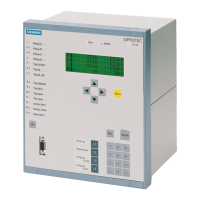2.5 Distance Protection
137
7SD5 Manual
C53000-G1176-C169-1
2.5.2 Distance Protection with Quadrilateral Characteristic (optional)
A tripping characteristic in the shape of a polygon is defined for each of the distance
zones.
2.5.2.1 Method of Operation
Operating
Polygons
In total there are five independent and one additional controlled zone for each fault im-
pedance loop. Figure 2-41 shows the shape of the polygons as example. The first
zone is shaded and forward directional. The third zone is reverse directional.
In general, the polygon is defined by means of a parallelogram which intersects the
axes with the values R and X as well as the tilt ϕ
Dist
. A load trapezoid with the setting
R
Load
and ϕ
Load
may be used to cut the area of the load impedance out of the polygon.
The axial coordinates can be set individually for each zone; ϕ
Dist
, R
Load
and ϕ
Load
are
common for all zones. The parallelogram is symmetrical with respect to the origin of
the R–X–coordinate system; the directional characteristic however limits the tripping
range to the desired quadrants (refer to „Determination of Direction“ below).
The R-reach may be set separately for the phase-phase faults and the phase-earth
faults to achieve a larger fault resistance coverage for earth faults if this is desired.
For the first zone Z1 an additional settable tilt α exists, which may be used to prevent
overreach resulting from angle variance and/or two ended infeed to short-circuits with
fault resistance. For Z1B and the higher zones this tilt does not exist.
3820 Dis.Trip <-> OUT Dist.: Trip by fault detec, rev/non-dir.
3821 Dis.TRIP 3p. Z4 OUT Distance TRIP 3phase in Z4
3822 Dis.TRIP 3p. Z5 OUT Distance TRIP 3phase in Z5
3823 DisTRIP3p. Z1sf OUT DisTRIP 3phase in Z1 with single-ph Flt.
3824 DisTRIP3p. Z1mf OUT DisTRIP 3phase in Z1 with multi-ph Flt.
3825 DisTRIP3p.Z1Bsf OUT DisTRIP 3phase in Z1B with single-ph Flt
3826 DisTRIP3p Z1Bmf OUT DisTRIP 3phase in Z1B with multi-ph Flt.
3850 DisTRIP Z1B Tel OUT DisTRIP Z1B with Teleprotection scheme
No. Information Type of In-
formation
Comments
www . ElectricalPartManuals . com
